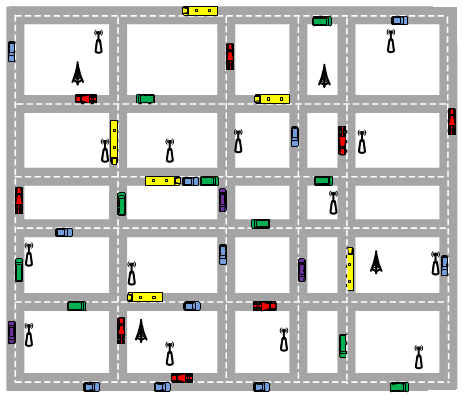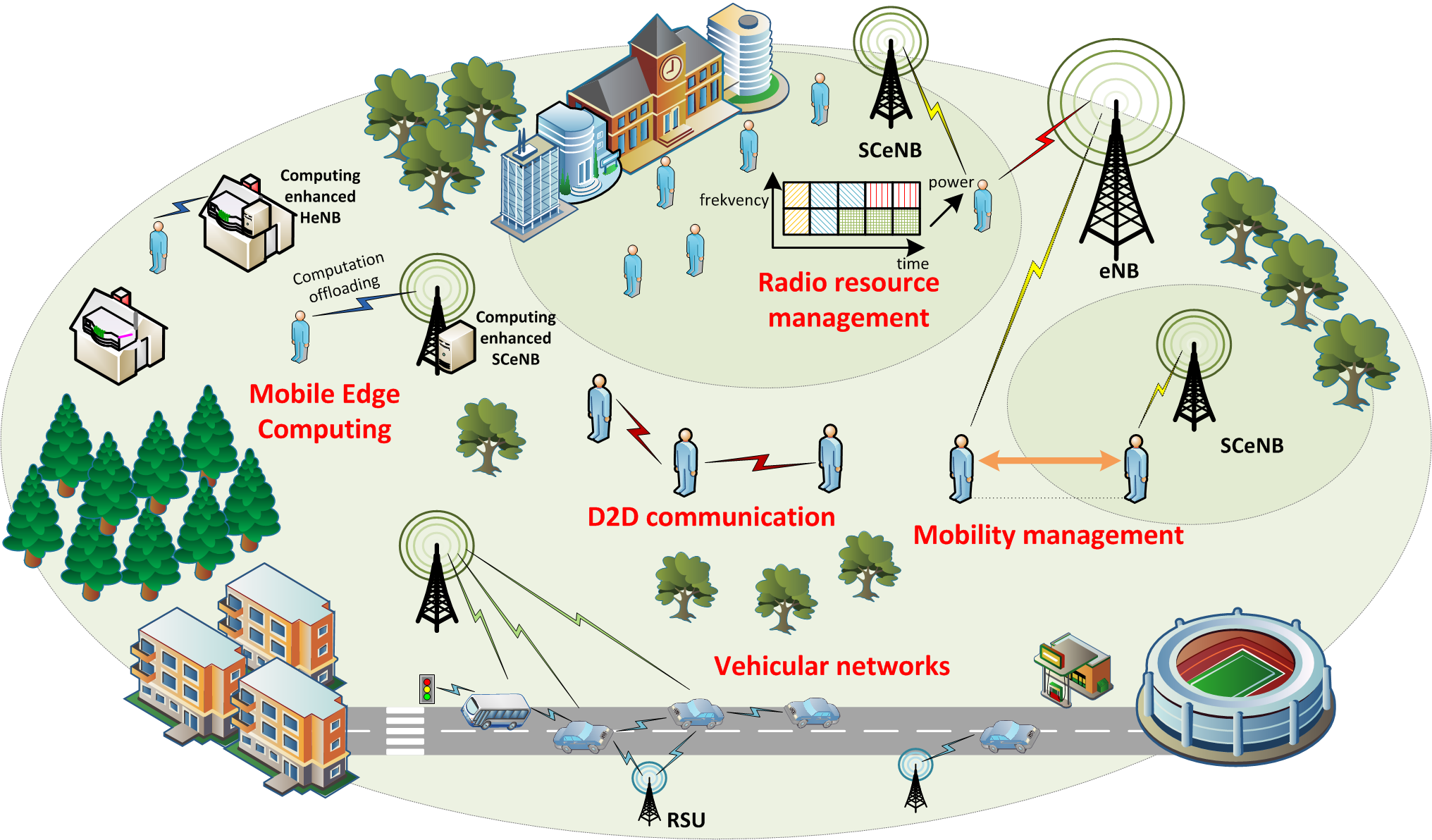Activities
5GM focuses on key aspects and challenges related to future mobile networks and emerging wireless technologies. The 5GM is oriented mainly on topics related to control layers such as mobility and radio resource management for self-organizing and energy efficient mobile networks. Furthermore, we address network architecture including mobile edge computing. From 5G scenarios perspective, the 5GM research is oriented mainly on scenarios encompassing ultra-dense networks, device-to-device communication, vehicular ad-hoc networks, and intelligent transportation systems.
The overview on main activities and work carried out in the past is split into following areas:
For cellular networks, mobility is an essential feature. Mobility management procedures at all stages, i.e., scanning of neighborhood, handover decision and call admission control, for future mobile networks cope especially with high density of base stations. The management enabling users’ mobility must guarantee quality required by users in quickly changing environment with heterogeneous services, technologies and cells. Efficient management of such a complex problem can be ensured by self-organizing and optimizing algorithms exploiting prediction and machine learning approaches to estimate future characteristics and behavior of users and network and adapt parameters of mobility management accordingly.
Neighborhood scanning
We design algorithms optimizing procedure of scanning of potential target cells if a user is moving. Our first approach is based on dynamic optimization of a set of scanned cells according to the SINR observed by a user equipment from its serving cell. If the user equipment is in the cell center, only the serving cell is scanned. Contrary, if the UE moves closer to the cell edge, also other cells are inserted to the list of scanned cells. The cells are included in the list based on the probability of handover to these cells. Furthermore, we work on new scanning scheme maximizing utilization of the small cells and minimizing energy consumption due to scanning. The proposal exploits graph theory to represent a principle of obstructed paths in combination with knowledge of previous visited cell and estimated distance between cells.
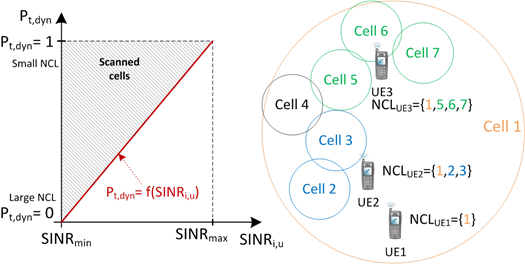
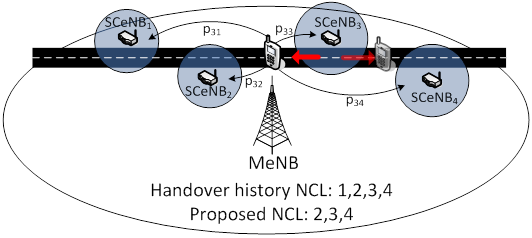
Handover decision
For handover decision, we improve efficiency of handover decision process to avoid redundant handovers between neighboring cells. We targets mainly scenarios with densely deployed small cells as these are an integral part of 5G mobile networks. Our approaches include adaptive hysteresis or estimation of gain experienced by users if he/she performs handover to a target cell.
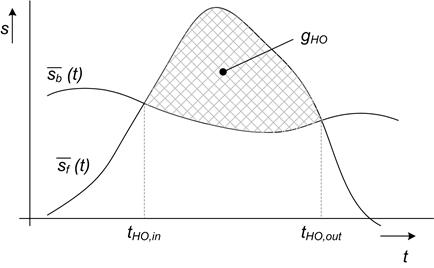
Fast Cell Selection
We have also proposed coordinated communication of a user with several neighboring cells by means of Fast Cell Selection in OFDMA networks. For each frame, the most suitable cell which transmits/receive data to/from users is selected. This approach enables to minimize the number of hard handovers and, consequently, the interruption in communication due to handover is eliminated.
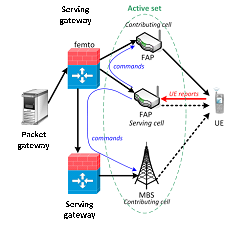
Call Admission Control
For Call admission control, we define algorithms predicting signal quality received by the user just after handover based on knowledge of current signal levels observed from serving and neighboring cells. Together with prediction of user mobility and handover, we can efficiency decide about admission of users to a target cell and reduce number of call drops.
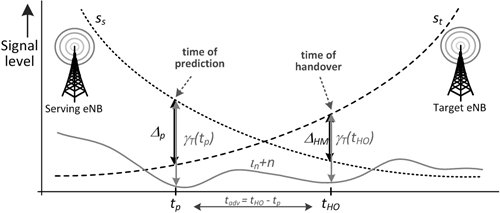
Radio resource management plays an important role in mobile wireless networks. The general objective of radio resource management is to efficiently utilize the limited spectrum resources in both time and frequency domain in order to guarantee Quality of Service to individual users. It incorporates various strategies and algorithms for controlling transmission power, allocation ofradio resources to users, determining modulation and coding scheme, etc.
QoS-Guaranteed Power Control Mechanism for Femtocells
The basic idea of our developed power control is to adapt the transmission power of femtocells according to current traffic load and signal quality between the user equipments and the femtocell in order to fully utilize radio resources allocated to the femtocell. The advantage of the proposed scheme is in provisioning of high quality of service level to the femtocell users, while interference to users attached to macro base station is minimized.
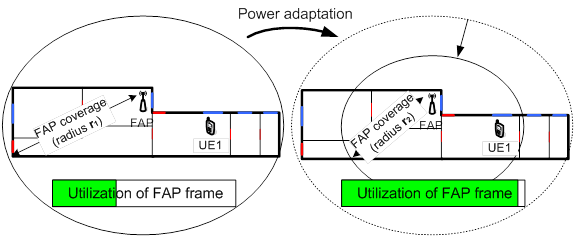
Dynamic Resource Allocation
In this work, we focus on mitigation of cross-tier and co-tier interference for dense deployment of the femtocells. The femtocells either utilize an overlapping allocation mode or a non-overlapping allocation mode. The allocation mode is dynamically selected by a control unit depending on the changing interference pattern among individual femtocells. In order to create interference matrix among the femtocells, Bron-Kerbosch algorithm is used.
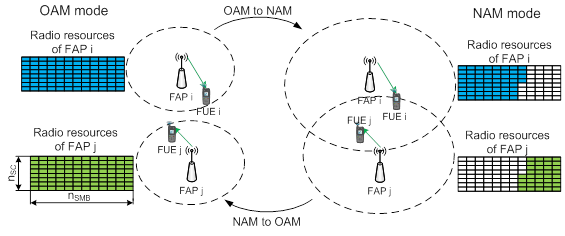
Hybrid Spectrum Sharing for Interference Mitigation
In this topic, we address the problem of interference caused by femtocells to macrocells. The solution is based on cognitive femtocell concept where the femtocells can access the frequency spectrum of more than one cellular operator. To guarantee QoS to the femtocell user even at heavy load, and despite low transmitting power, the femtocells can opportunistically access frequency bands of other cellular operators.
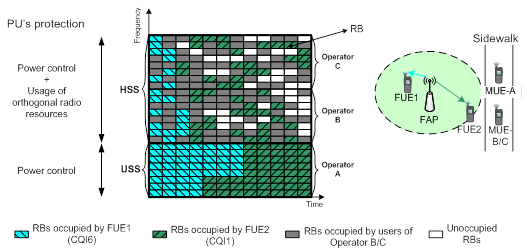
Direct communication between two or more devices without the intervention of a base station, known as device-to device (D2D) communication, is a promising way to improve performance of cellular networks in terms of spectral and energy efficiency. The most common use of D2D communication in cellular networks is the offloading local traffic from an base station evolved Node B (eNB), sharing specific contents between close users or for gaming purposes. In addition, D2D enables multicasts/broadcasts of user information to several devices in proximity, or relaying of data using user equipments instead of conventional relay nodes. Nevertheless, D2D communication introduces several critical problems, such as interference management, decisions on whether devices should communicate directly or not, D2D mobility or security and privacy issues.
Selected work of 5GM in this domain:Radio resource management for D2D
We focus on efficient data transmission in scenario with local communication between two users attached to the same femtocell.We have proposed a novel routing scheme managing data transmission within a femtocell based on D2D principle. The routing path between users is dynamically selected from two hops transmission to direct one whenever the system can profit from it. In addition, we have developed a management procedure in order to implement our routing scheme into LTE standard. We also address problems of interference and mobility management for D2D in cellular networks.
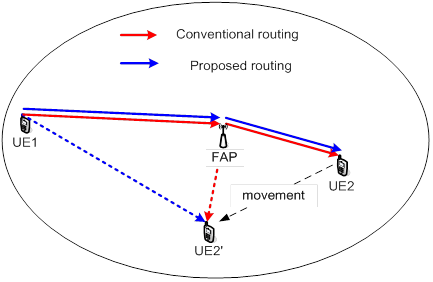
Mobile cloud services are exploited for offloading a computation from mobile devices or for data storing purposes. However, the conventional centralized cloud may result in high delay of offloaded data delivery and in congestion of backhaul due to transmission of the offloaded data. The perceived delay caused by the centralized cloud can be minimized by adopting a distributed cloud deployed over base stations of cellular network. This concept, denoted as Mobile Edge Computing or Small Cell Cloud, requires new architecture of mobile networks enabling joint allocation of communication and computing resources for heterogeneous services. Besides architecture, also new approaches for resource allocation and mobility management considering energy consumption at the mobile device are needed.
Architecture of Small Cell Cloud
We participate on modification of mobile network architecture to enable management of computing and storage resources deployed over enhanced small cells. Together with other partners, we have proposed integration of Small cell Cloud Manager into existing mobile networks. Moreover, we have proposed implementation of the Small cell Cloud Manager is by means of virtual-hybrid control of computing resources where virtualized computing power at small cells is shared for computation of user application as well as for management of computing resources.
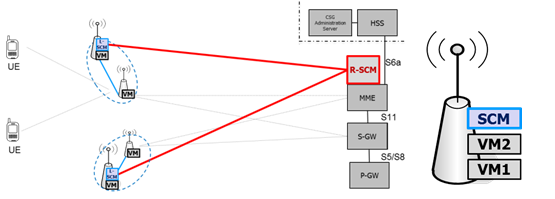
Path selection enabling mobility of users while computation is in progress
We work on algorithm optimizing delay and/or energy consumption of the user equipment for delivery of parallelized computing tasks to the cloud-enhanced small cells, which are selected for computation. Our proposed approach selects the most suitable path for each part of data and delivers data to intended cell through radio and/or backhaul. This enables also mobility of users if the computation is in progress.
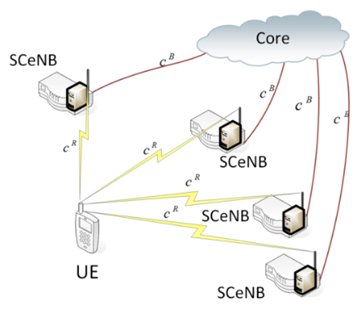
Guaranteeing QoS by power control
We have also design control algorithm, which purpose is to guarantee that the requests processed by the cloud are received by the UE within required delay. This is done by coarse and dynamic fine setting of the small cells’ transmitting power level.
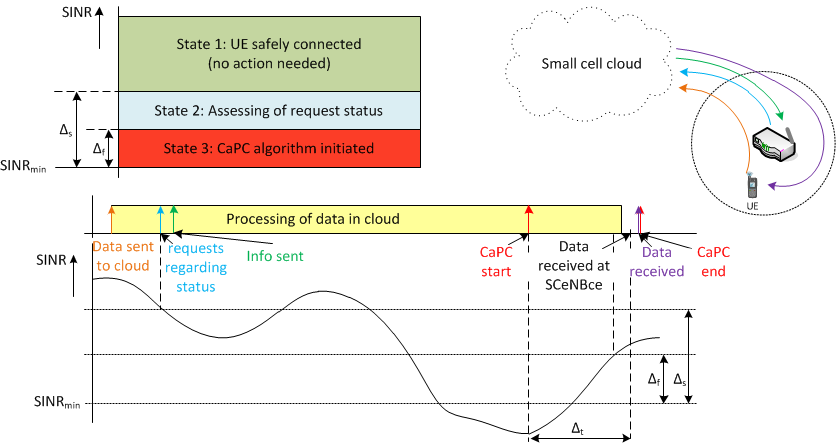
Intelligent transportation system (ITS) enables efficient and safety control of traffic flow resulting in improvement of driver’s experience. ITS exploits information obtained from various sensor deployed around road or on board of vehicles. One of the main challenge in ITS is exchange of collected information from sensors among vehicles or among vehicles and infrastructure via heterogeneous networks composed of 802.11p, cellular networks, etc. Furthermore, sharing of heterogeneous radio resources for traffic and sensor information with user’s data by integration of VANET to 4G+/5G mobile networks is foreseen in the future.
Selected work of 5GM in this domain:
We proposed algorithm that enables route selection based on maximum expected signal quality with respect to the drivers’ maximum tolerated prolongation of journey. The ultimate is to select the route that ensures sufficient signal quality for users on board by maximizing the usage of vehicular ad-hoc networks resources, through Route Side Units, while minimizing the usage of the costly LTE-A resources.
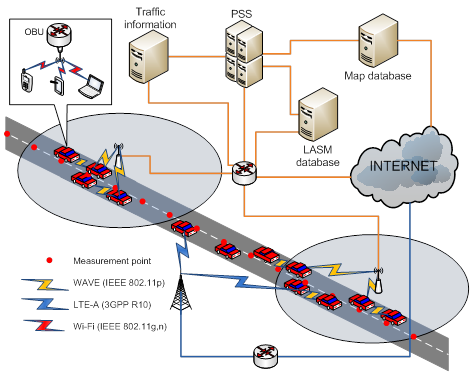
For evaluation of above-mentioned approaches and their comparison with conventional and state of the art proposals, an appropriate simulation models have to be chosen. In mobility models, the precision of simulated movement and truly modelling of mobile users’ movement plays an important role. We have developed two specific mobility models for modeling of pedestrians’ and vehicles’ movement based on typical movement characteristics of pedestrians and vehicles. All our models and simulations are developed in MATLAB. It provides a wide scalability of our models while the precision of model remains preserved.
Selected work of 5GM in this domain:Mobility model for pedestrians
Pedestrian mobility model represents a part of Prague (Czech Republic). The mobility model exploits graph theory approach for finding the shortest possible path between two points of interest. Once a user reaches its destination, she/he chooses another destination and starts moving again. The probability that a user visits a point of interest is derived from real behavior of the users in the area. Based on the observation, four types of users are classified: workers, residents, visitors, and roaming residents. All parameters of simulation environment or mobility model can be easily modified or enhanced.
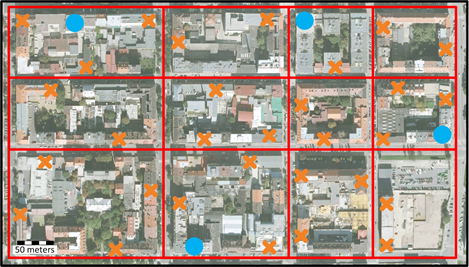
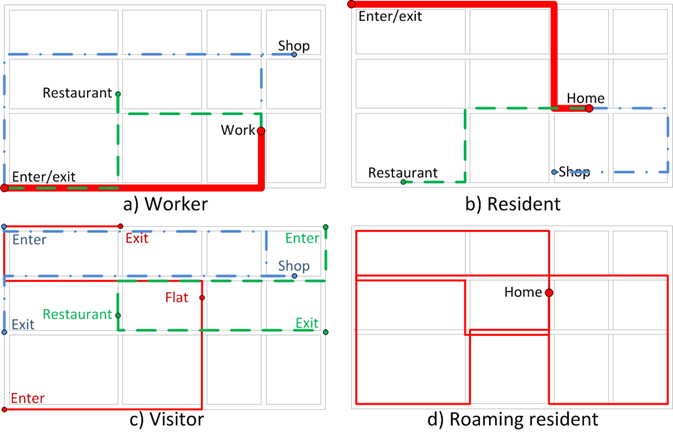
Mobility model for vehicles
Vehicular mobility model is represented by the set of perpendicular vertical and horizontal bidirectional streets. In the model, different types of vehicles represent individual driving style of each driver/vehicle moving through streets. For each vehicle, unique origin place, destination place and dynamic characteristics, such as, maximum acceleration, average speed, etc., are selected randomly. The behavior of vehicles is similar to real traffic pattern as vehicles take traffic environment into account. The vehicles smoothly accelerate on the direct path as well as gradually decelerate in front of intersections or close to a queue of other vehicles. Developed model allows to set the number of streets, their length as well dynamic characteristics as arbitrarily.
